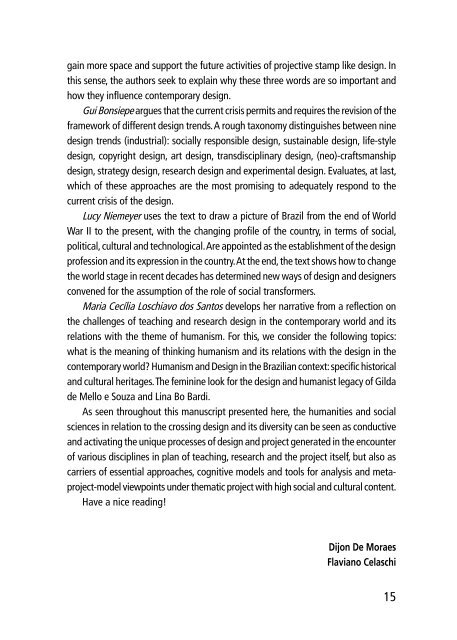o_19po8js951tvs1r0t1r8s4bb1vpla.pdf
Create successful ePaper yourself
Turn your PDF publications into a flip-book with our unique Google optimized e-Paper software.
gain more space and support the future activities of projective stamp like design. In<br />
this sense, the authors seek to explain why these three words are so important and<br />
how they influence contemporary design.<br />
Gui Bonsiepe argues that the current crisis permits and requires the revision of the<br />
framework of different design trends. A rough taxonomy distinguishes between nine<br />
design trends (industrial): socially responsible design, sustainable design, life-style<br />
design, copyright design, art design, transdisciplinary design, (neo)-craftsmanship<br />
design, strategy design, research design and experimental design. Evaluates, at last,<br />
which of these approaches are the most promising to adequately respond to the<br />
current crisis of the design.<br />
Lucy Niemeyer uses the text to draw a picture of Brazil from the end of World<br />
War II to the present, with the changing profile of the country, in terms of social,<br />
political, cultural and technological. Are appointed as the establishment of the design<br />
profession and its expression in the country. At the end, the text shows how to change<br />
the world stage in recent decades has determined new ways of design and designers<br />
convened for the assumption of the role of social transformers.<br />
Maria Cecília Loschiavo dos Santos develops her narrative from a reflection on<br />
the challenges of teaching and research design in the contemporary world and its<br />
relations with the theme of humanism. For this, we consider the following topics:<br />
what is the meaning of thinking humanism and its relations with the design in the<br />
contemporary world? Humanism and Design in the Brazilian context: specific historical<br />
and cultural heritages. The feminine look for the design and humanist legacy of Gilda<br />
de Mello e Souza and Lina Bo Bardi.<br />
As seen throughout this manuscript presented here, the humanities and social<br />
sciences in relation to the crossing design and its diversity can be seen as conductive<br />
and activating the unique processes of design and project generated in the encounter<br />
of various disciplines in plan of teaching, research and the project itself, but also as<br />
carriers of essential approaches, cognitive models and tools for analysis and metaproject-model<br />
viewpoints under thematic project with high social and cultural content.<br />
Have a nice reading!<br />
Dijon De Moraes<br />
Flaviano Celaschi<br />
15



